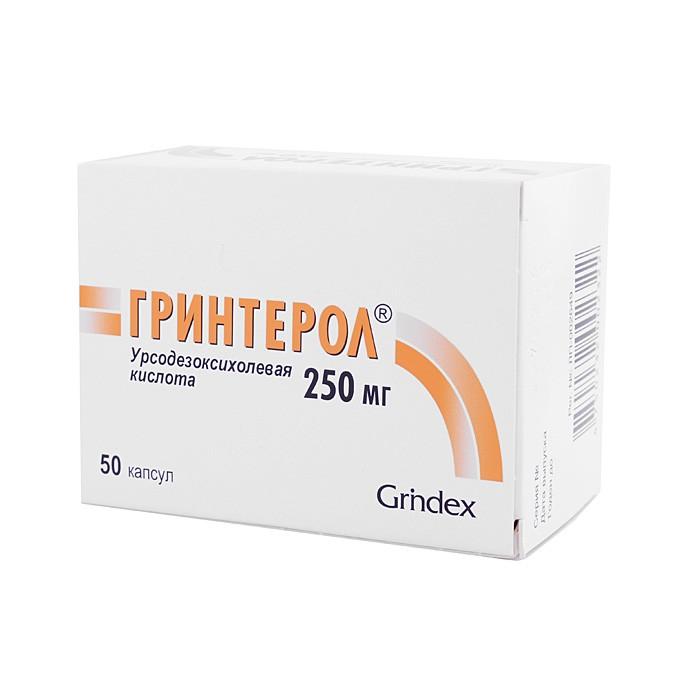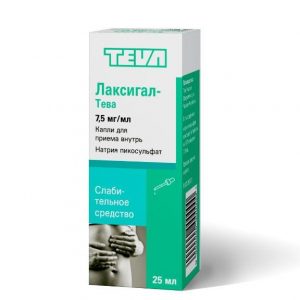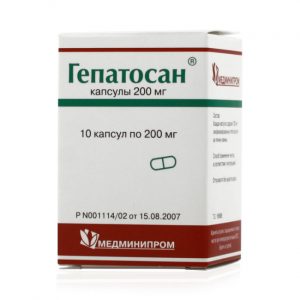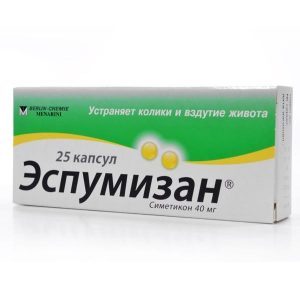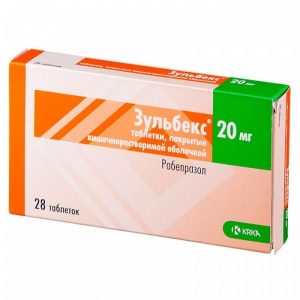Description
Release form
Capsules.
Packing
50 pcs.
Pharmacological action
Pharmacodynamics
Hepatoprotective agent also has choleretic, cholelitolytic, hypolipidemic, hypocholesterolemic and some immunomodulatory effects.
Integrates into the hepatocyte membrane, stabilizes its structure and protects the hepatocyte from the damaging effects of bile salts, thereby reducing their cytotoxic effect. In case of cholestasis, it activates a Ca2 + -dependent alpha protease and stimulates exocytosis, reduces the concentration of toxic bile acids (chenodeoxycholic, lithocholic, deoxycholic, etc.), the concentrations of which are increased in patients with chronic liver diseases.
Competitively reduces the absorption of lipophilic bile acids in the intestine, increases their “fractional” turnover during enterohepatic circulation, induces choleresis, stimulates the passage of bile and the elimination of toxic bile acids through the intestines. It screens non-polar bile acids (chenodeoxycholic), due to which mixed (non-toxic) micelles are formed.
Reduces cholesterol saturation of bile by reducing the synthesis and secretion of cholesterol in the liver and inhibiting its absorption in the intestine.
Increases the solubility of cholesterol in the biliary system, stimulates the formation and secretion of bile. It reduces the lithogenicity of bile, increases the concentration of bile acids in it, causes an increase in gastric and pancreatic secretion, enhances lipase activity, and has a hypoglycemic effect. Causes partial or complete dissolution of cholesterol gallstones when used internally, reduces the saturation of bile with cholesterol, which contributes to its mobilization from gallstones.
It has an immunomodulatory effect, affects immunological reactions in the liver: it reduces the expression of certain histocompatibility antigens – HLA-1 on the hepatocyte membrane and HLA-2 on cholangiocytes, affects the number of T-lymphocytes, the formation of interleukin 2, reduces the number of eosinophils, suppresses immunocompetent Ig ( primarily IgM).
Pharmacokinetics
Absorption from the small intestine is high (about 90%). Penetrates through the placental barrier. With max ingestion of 50 mg after 30, 60, 90 min – 3.8 5.5 3.7 mmol / L, respectively. TCmax – 1-3 hours. Communication with plasma proteins is high.
Metabolized in the liver (clearance during the “primary passage” through the liver) to taurine and glycine conjugates, which are secreted into bile. It is excreted by 50 70% through the intestines. A small amount of non-absorbable ursodeoxycholic acid enters the large intestine, where it is digested by bacteria (7 Dehydroxylation), the resulting lithocholic acid is partially absorbed from the colon, but is sulfated in the liver and quickly excreted as sulfolithocholylglycine or sulfolithocholyltaurin conjugate.
srd readingslkp Dissolution of small and medium cholesterol stones with a functioning gall bladder,
– biliary reflux gastritis,
– primary biliary cirrhosis of the liver with no signs of decompensation (symptomatic therapy),
– chronic hepatitis of various origins,
– primary sclerosing, sclerosing, primary cystic fibrosis),
– non-alcoholic steatohepatitis,
– alcoholic liver disease (ABP),
– biliary dyskinesia.
Contraindications
– Hypersensitivity to the components of the drug
– X-ray positive (high Ca2 +) gallstones
– nonfunctioning gallbladder
– acute inflammatory diseases of the gallbladder, bile ducts and intestines srdlkrp – cirrhosis – cirrhosis / or renal failure
– pancreatitis
– children’s age up to 3 years (for capsules).
Precautions:
Children 3 to 4 years of age should be used with caution, as it may be difficult to swallow capsules.
Use in pregnancy and lactation
In animal studies, no mutagenic and carcinogenic effects were found, however, due to the lack of clinical studies in pregnant women, use during pregnancy is possible only if the expected benefit to the mother outweighs the potential risk to the fetus.
No data are available on breast milk. therefore, if necessary, use during lactation should abandon breastfeeding.
Special instructions
Treatment should be carried out under the supervision of a physician.
When prescribed for the purpose of dissolving gallstones, monitoring of the activity of ² Ñliver ² Ñ transaminases and silk phosphatase, gamma-glutamyl transpeptidase, and bilirubin concentration is necessary. Cholecystography should be performed every 4 weeks in the first 3 months of treatment, then every 3 months. Monitoring the effectiveness of treatment is carried out every 6 months during an ultrasound examination (ultrasound) during the first year of therapy.
While maintaining elevated levels, the drug should be discontinued.
For successful dissolution, it is necessary that the stones are purely cholesterol, no larger than 15-20 mm in size, the gallbladder is filled with stones no more than half and the bile ducts fully retain their function.
After complete dissolution of the calculus, it is recommended that you continue to use it for at least 3 months in order to help dissolve the residues of calculi that are too small to detect.
If, within 6-12 months after the start of therapy, partial dissolution of stones did not occur, it is unlikely that the treatment will be effective.
Detection during treatment of an unimaginable gallbladder indicates that complete dissolution of calculi has not occurred and treatment should be discontinued.
In patients with diarrhea, the dosage of ursodeoxycholic acid should be reduced. With persistent diarrhea, treatment should be discontinued.
Long-term therapy with high doses of ursodeoxycholic acid (28-30 mg / kg / day) can lead to the development of serious side effects in patients with primary sclerosing cholangitis.
Influence on ability to drive vehicles, mechanisms:
Influence on ability to drive vehicles, mechanisms not revealed.
Composition of
One capsule contains:
active substance:
ursodeoxycholic acid – 250.0 mg
excipients:
corn starch – 73.0 mg,
silicon dioxide – 5.0 mg,
magnesium 2.0 mg
capsule (body and cap):
titanium dioxide (E 171) – 2%, gelatin – up to 100%.
Description:
No. 0 hard gelatine capsules, white body and lid.
Content – white or almost white powder.
Dosage and Administration
Inside. Capsules are taken in the evening, without chewing, with a little water.
Dissolution of gallbladder cholesterol stones: average daily dose is 10 mg / kg, which corresponds to:
Body weight (kg)
Number of capsules
Up to 60
2
61-80
3
81-100
4
4 srd
The course of treatment is 6-12 months. To prevent re-formation of stones, it is recommended that the drug be taken for a few more months after the stones dissolve.
Treatment of biliary reflux gastritis: one 250 mg capsule once daily in the evening. The course of treatment is from 10-14 days to 6 months, if necessary – up to 2 years.
Symptomatic treatment of primary biliary cirrhosis in the absence of signs of decompensation: 10-15 mg / kg (if necessary, up to 20 mg / kg) per day in 2 3 doses in the first 3 months of treatment. After improving hepatic indices, the daily dose can be used once in the evening.
Recommended application mode:
Body weight
(kg)
Daily dose
(number of capsules)
In the morning
In the afternoon
In the evening
47-62
3
1
1
1
1 1 srdlpp 1 63 srdlpp 1 93
5
1
2
2
94-109
6
2
2
2
Over 100
7
2
2
3
Duration of treatment. In rare cases, clinical symptoms may worsen at the beginning of treatment (itching becomes more frequent). In this case, one capsule should be used daily, then the dosage should be gradually increased (increasing the daily dose by one capsule weekly) until the recommended dosage regimen is reached.
Symptomatic treatment of chronic hepatitis of various origins: the daily dose is 10-15 mg / kg in 2-3 doses. The duration of treatment is 6-12 months or more.
Primary sclerosing cholangitis: 12-15 mg / kg (up to 20 mg / kg) of body weight per day in 2 3 doses. Duration of use – from 6 months to several years.
Cystic fibrosis (cystic fibrosis): 20-30 mg / kg per day in 2-3 doses. Duration of use – from 6 months to several years.
Non-alcoholic steatohepatitis: the average daily dose is 10-15 mg / kg in 2 3 doses. Duration of use – from 6-12 months or more.
Children aged 3 years and over are prescribed individually, at the rate of 10-20 mg / kg per day.
Alcoholic liver disease: the average daily dose is 10-15 mg / kg in 2-3 doses. The duration of therapy is 6-12 months or more.
Biliary dyskinesia: the average daily dose of 10 mg / kg in 2 divided doses for 2 weeks to 2 months. If necessary, the treatment is recommended to be repeated.
Children and adults with body weight less than 47 kg are recommended to use the drug in suspensions of other manufacturers.
Side effects
Disorders of the gastrointestinal tract: loose stools or diarrhea. In the treatment of primary biliary cirrhosis, acute pain in the upper right abdomen may occur.
Disorders of the liver and biliary tract: calcification of gallstones. In the treatment of primary biliary cirrhosis, transient decompensation of cirrhosis of the liver (occurs after discontinuation of the drug) may be observed.
Disorders of the skin and subcutaneous tissue: allergic reactions (including urticaria).
Drug interactions
Antacids containing aluminum hydroxide, aluminum oxide and ion-exchange resins (colestyramine, colestipol) reduce the absorption of ursodeoxycholic acid in the intestine, thus reducing its effectiveness, therefore, the listed drugs should be used 2 hours before taking ursodeoxycholic acid.
Ursodeoxycholic acid can enhance the absorption of cyclosporin from the intestine, so the dose of cyclosporin should be adjusted when used simultaneously.
Ursodeoxycholic acid may decrease the absorption of ciprofloxacin.
Hypolipidemic drugs (especially clofibrate), estrogens, neomycin or progestins, oral contraceptives increase bile saturation with cholesterol and may decrease the ability to dissolve cholesterol bile calculi.
Overdose
There are no known cases of overdose of ursodeoxycholic acid.
Storage Conditions
Do not store above 25 ° C.
Keep out of the reach and sight of children.
Shelf life
2 years. Do not use after the expiration date indicated on the package.
Deystvuyushtee substance
ursodeoxycholic acid
Terms and conditions
prescription
dosage form
capsules
Possible product names
Greenterol 0.25 caps 50 pcs
